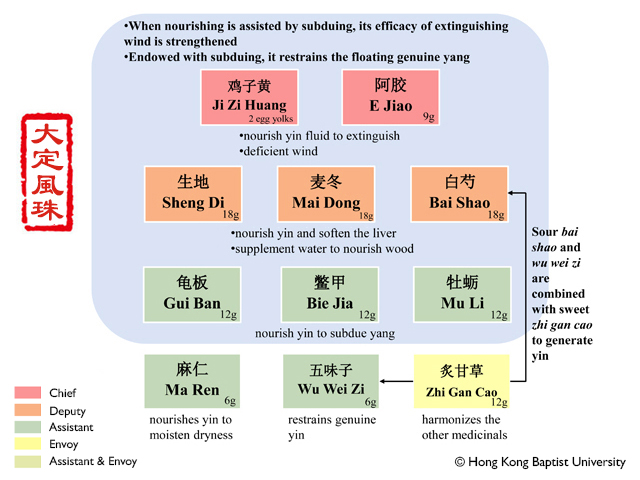| 【Chinese Name】 |
大定風珠
|
| 【Phonetic】 |
Da Ding Feng Zhu
|
| 【English Name】 |
Major Wind-Stabilizing Pill |
| 【Classification】 |
Wind-calming formulas |
| 【Source】 |
《Systematic Differentiation of Warm Diseases》Wen Bing Tiao Bian《溫病條辨》 |
| 【Combination】 |
Paeoniae Radix Alba (Sheng Bai Hao) 6 qian (18g), Asini Corii Colla (E Jiao) 3 qian (9g), Testudinis Plastrum (Sheng Gui Ban) 4 qian (12g), Rehmanniae Radix (Gan Di Huang) 6 qian (18g), Cannabis Fructus (Ma Ren) 2 qian (6g), Schisandrae Chinensis Fructus (Wu Wei Zi) 2 qian (6g), Ostreae Concha (Sheng Mu Li) 4 qian (12g), Ophiopogonis Radix (Mai Dong) 6 qian (18g), Glycyrrhizae Radix et Rhizoma Praeparata cum Melle (Zhi Gan Cao) 4 qian (12g), Egg Yolk (Ji Zi Huang) 2 yolks (2 yolks), Trionycis Carapax (Bie Jia) 4 qian (12g) |
| 【Method】 |
Prepare the ingredients, except e jiao and ji zi huang, as a decoction for oral use. Add e jiao by melting it into the decoction, and blend ji zi huang into the strained decoction while stirring equably. |
| 【Action】 |
Enriches yin and extinguishes wind. |
| 【Indication】 |
Da Ding Feng Zhu is indicated for a pattern of stirring of wind due to yin deficiency. The symptoms are clonic convulsions of the extremities, weak physique, lassitude of the spirit, a deep red tongue body with a scanty tongue coating, and a weak pulse; patients have a strong tendency of desertion. |
| 【Pathogenesis】 |
This is a pattern caused by the prolonged retention of pathogenic heat damaging the genuine yin in the late stage of warm disease; if sweating had been induced incorrectly or if purged incorrectly, yin-fluids would be damaged, which leads to wind stirring. When the liver and kidney yin-fluids are exhausted, water fails to nourish wood, which stirs up deficient wind; convulsive limbs may also result. Exhausting genuine yin results in yang having no place to adhere to. Therefore there is emaciation and lassitude, a crimson tongue with a scanty coating, a weak pulse, and the tendency of desertion. The fundamental feature of this pattern is that the pathogenic heat is nearly eliminated, but there is only a little genuine yin left and is on the edge of desertion. The therapeutic principles used to remedy this pattern are to nourish yin-fluids to supplement the exhausting genuine yin and calm and extinguish the internal stirring of deficient wind. |
| 【Application】 |
1. Essential pattern differentiation
Da Ding Feng Zhu serves as the most common formula used for severe damage of kidney yin with internal stirring of deficient wind in the late stage of warm disease. This clinical pattern is marked by convulsions, lassitude, crimson colored tongue body.
2. Modern applications
This formula may be used in the following biomedically defined disorders when the patient shows signs and symptoms of stirring of wind due to yin deficiency such as Japanese B encephalitis sequelae, stroke sequelae, hyperthyroidism and neuropathic vibrations.
3. Cautions and contraindications
This formula is not applicable to patients with deficient yin-fluids and excessive pathogenic heat. |
| 【Additonal formulae】 |
1. San Jia Fu Mai Tang (Three Shells Pulse-Restoring Decoction 三甲復脈湯)
[Source]《Systematic Differentiation of Warm Diseases》Wen Bing Tiao Bian《温病条辨》
[Ingredients] Zhi gan cao 6 qian (18g), gan di huang 6 qian (18g), sheng bai shao 6 qian (18g), mai dong 5 qian (15g), e jiao 3 qian (9g), ma ren 3 qian (9g), sheng mu li 5 qian (15g), sheng bie jia 8 qian (24g), sheng gui ban 1 liang (30g)
[Preparation and Administration] Prepare it as a decoction.
[Actions] Nourishes yin to extinguish wind.
[Applicable Patterns] Prolonged retention of pathogenic heat in the lower jiao and deep heat with severe reversal cold in a warm disease. Symptoms include: notable palpitations or even angina, wriggling of the extremities, a crimson colored tongue body with a scanty coating, and a wiry, racing pulse.
2. E Jiao Ji Zi Huang Tang (Donkey-Hide Gelatin and Egg Yolk Decoction 阿胶鸡子黄汤)
[Source]《Popular Guide to the Treatise on Cold Damage 》Tong Su Shang Han Lun《通俗伤寒论》
[Ingredients] E jiao 2 qian (6g) (melted into the decoction and infused), bai shao 3 qian (9g), shi jue ming 5 qian (15g), gou teng 2 qian (6g), sheng di 4 qian (12g), gan cao 6 fen (2g), sheng mu li 4 qian (12g), luo shi teng 3 qian (9g), fu shen 4 qian (12g), ji zi huang 2 yolks
[Preparation and Administration] Ji zi huang is decocted first and then used in place of water to decoct other medicinals
[Actions] Enriches yin and nourishes blood, softens the liver and extinguishes wind.
[Applicable Patterns] Prolonged retention of pathogenic heat, insufficient yin-blood, deficient wind stirring internally. Symptoms include: spasms of the sinews, convulsions of the extremities, vexation and insomnia, vertigo, a crimson colored tongue body with scanty coating, and a wiry, rapid pulse. |
| 【Remark】 |
1. Chinese soft-shelled turtle (Trionyx sinensis / Pelodiscus sinensis) is listed as "Vulnerable" in the International Union for the Conservation of Nature and Natural Resources (IUCN) Red List of Threatened Species. Also, it is protected by |
|
|




